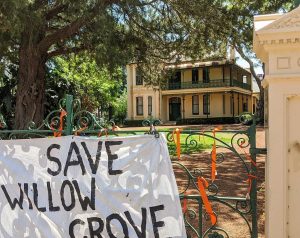The National Trust (NSW) has welcomed the NSW government’s recent decision not to rebuild historic 19th-century Willow Grove house in Parramatta. The decision sheds light on why we must save existing heritage icons – not rebuild them.
Built between 1870 and 1880, the Willow Grove villa was torn down in 2021 to make way for the new Powerhouse Museum in Parramatta, despite opposition from community groups and the National Trust.
Parts of Willow Grove were saved and kept in storage for reconstruction at an alternative site, but current Arts Minister John Graham has recently dismissed the plan, saying a rebuild would be a “terrible idea”.
The National Trust has continually fought for the conservation of historic Willow Grove, and the recent revelation that it will not be put back together comes as a relief, given there were major concerns about the reconstruction process.
Instead, the National Trust looks forward to seeing these funds potentially reallocated for authentic heritage conservation in Parramatta – in particular, the iconic Roxy Theatre, which is in desperate need of revitalisation.
Why was Willow Grove so special?

The Italianate villa was a beautiful piece of 19th century architecture, and a rare surviving Victorian residential development in the ever-growing city of Parramatta.
Beyond its aesthetic beauty, it was also home to many stories of early women’s rights and entrepreneurship.
The original land purchase to develop the Willow Grove dwelling was completed in 1885 by a Thomas Ellis, but with the certificate of title issued to his wife, Rebecca.
The next owner of the property was another woman, Annie Hanley, a woman of her own means who was assisted by the historic Married Women’s Property Act 1879.
This Act, a landmark in Australian history, allowed married women to manage and protect their own finances and assets separate to their husbands. Annie was a successful businesswoman, and her thriving millinery operation allowed her the funds to purchase Willow Grove. It later passed into the ownership of Elizabeth Melhuish, again a successful property owner in her own right.
The dwelling would later become a maternity hospital from 1919-1953, purchased by midwife and matron E.E. Davidson. For more than thirty years, the building saw the birth of countless children, and provided a space to prioritise women’s reproductive and maternity care. It also employed dozens of nurses, creating a place for ongoing women’s employment.
Throughout its history, Willow Grove provided a continuously important story of women’s independence and generational stories.
What was the National Trust’s position on Willow Grove?
The National Trust maintained that because of Willow Grove’s historic and cultural significance, the building should remain in its original position and be sensitively repaired.
Relocation and reassembly was merely an alternative form of demolition, and the salvaged remains would not have afforded a suitable replacement for the existing form. Furthermore, this outcome would have severed the building from its landscape and context, its links to the river, and its location as part of the development of Parramatta.
The proposed solution had a negative heritage and social outcome. The community fought hard to save the building from demolition and also to avoid the building being put back together as a replica.
How does not rebuilding help heritage?

The Minns government’s recent announcement that they are scrapping plans to reassemble the remains of the building is a much better heritage outcome than trying to recreate the property.
The dismantling of Willow Grove would not only have robbed the building of its physical integrity, but also of its setting in the Parramatta community and rich connection to women’s history.
Instead, potentially redirecting focus towards saving existing heritage in Parramatta would have more long-reaching results, particularly for the nearby historic Roxy Theatre.
The Roxy, an Art Deco entertainment gem of Parramatta, is in desperate need of heritage conservation, and is currently being investigated for a revitalisation project.
To restore and reinvigorate this site once again into a cultural and artistic space would be a huge win for both the community, and for the heritage of Parramatta. It would also be a much more authentic form of heritage care than the Willow Grove replica.
The National Trust welcomes this outcome, noting that it is the best possible resolution for Willow Grove at this stage.
We hope that it sets an example of what not to do for the future. Our heritage connects us to place, to each other, and to our personal and collective identities. Like so much of our environment, we need to care for it with more kindness and more respect, not only for ourselves but also for inter-generational equity.
The National Trust (NSW)’s mission is to advocate for the conservation of built, cultural and natural heritage. Find out more about our advocacy work.
If you’d like to stay up-to-date on the latest National Trust news, events and special offers, subscribe to our free monthly newsletter.
